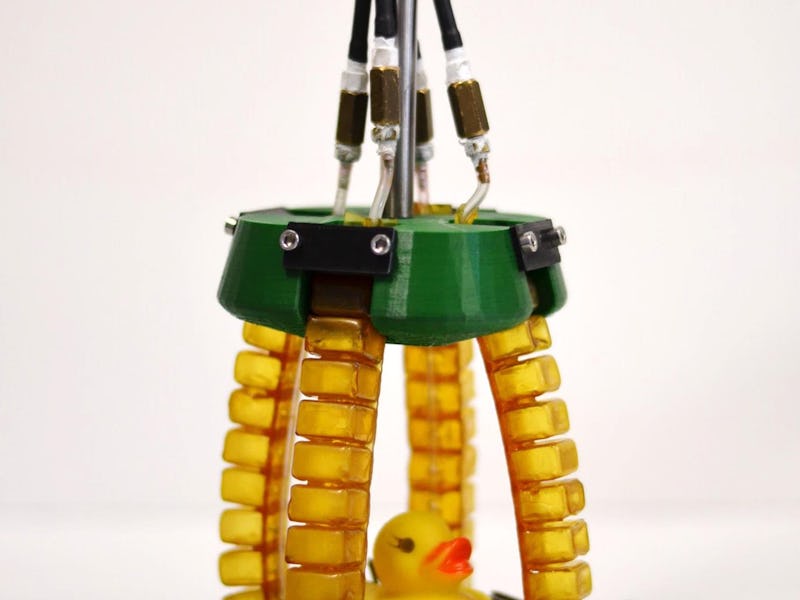In Isaac Asimov’s short story “The Bicentennial Man,” the legendary science fiction author imagines a robot who takes the name Andrew Martin. Andrew dreams of becoming human, as he moves from wearing clothes to having a digestive system implanted to, at the story’s end, having his robotic brain altered so it will decay and die just like a human one. He lives 200 years, as the title suggests, yet even that is a voluntary shortening of his potential lifespan if he had remained mechanical.
But even when a robot is made of nuts and bolts and wires, that doesn’t mean its parts won’t naturally degrade as time passes. Scientists, however, may have figured out a way to give robots the gift of longevity that could someday rival Andrew Martin’s, thanks to a self-healing material that also borrows a little something from how the human body works. These organic-inspired automatons are known as soft robots.
“Soft robots exist in several applications like grippers, crawling robots, soft robot arms for endoscopy,” study coauthor Bram Vanderborght, an engineer at Vrije Universiteit Brussel in Brussels, tells Inverse.
As described in Science Robotics, he and his colleagues in Belgium built and tested an array of what are known as soft robots. Any damage sustained by these robots is repaired on its own, without any lasting “scars” or sensitivity left over from the damage. The material could finally make such soft robots practical enough for industry to begin seriously developing these kinds of objects in the real world for practical purposes.
What exactly could a soft, squishy robot do? Think about the same sort of limitations the human body has when it comes to wiggling its way into small nooks and crannies, dangerous environments with delicate walls and floors and ceilings, moving through paths that might require a bit of shapeshifting, and even interacting safely with people.
“A robot needs to be over dimensioned (and hence made heavier) to withstand exceptional loads,” he says. “Moreover, often a robot is very complex and difficult to repair. Soft robots are especially susceptible to sharp objects. With this research, we made a first step to introduce self-healing materials in soft robotics, which we think will start a whole new research field of self-healing robotics.”
The different robots the team constructed included a soft pneumatic (operated by air) robotic gripper, and hand and artificial muscles out of self-healing elastomers.
The major obstacle, however, is just that — a soft robot is weaker and less durable because of what its made of. “Softness and flexibility also imply an increased vulnerability to all kinds of sharp objects and edges found in the uncertain environments in which these robots will function, which is also valid for soft organisms, as a matter of fact,” says Vanderborght.
The Belgian team, observing that soft robots are as delicate as living organisms, decided to find a solution inspired by life itself — hence the self-healing material. The group constructed three different objects: a robotic gripper, a hand, and a pneumatic artificial muscle — all using a material that was able to heal itself from damage in just 20 to 40 minutes of time.
Healing was induced through exposure of heat at about 80 degrees Celsius — enough to break the molecular bonds of the polymer and allow the material to seal the cut at both the macroscopic and microscopic levels once it cooled to room temperature. Each robot could perform its tasks as well as it could before damage and healing.
Repair efficiency, the researchers found, was about 98 to 99 percent. Moreover, the material could be dissolved in chloroform and repurposed into a different shape or object, paving the way for recycling soft-robots made of this material.
But the applications of this material don’t just stop at robots. “Robotics is one field,” says Vanderborght, but the new material can “extend also to other machines and home devices and provide self-healing properties.” Beyond just practical tasks, the material could facilitate “a new kind of trust in robots, knowing that their functional performance is not dependent — as it is now — on the human detection and repair of possible damages, which requires constant attentiveness or regular revisions.”
While the results are a boon for soft robotics itself, they are also a sign that engineers continue to use inspiration from the organic world to find solutions to problems in the artificial one. Self-healing robots are just another step toward self-actualizing ones. Sooner or later, a real Andrew Martin might well arrive.
